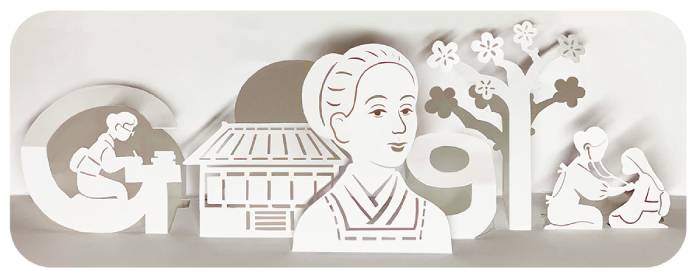Today’s Doodle honours Dr. Ogino Ginko, the first woman to be licenced to practise Western medicine in Japan, on her 171st birthday. She paved the way for women to attend top medical schools in Japan by being the first female to attend Kojuin, a private medical school for men.
Ginko Ogino was born in the Musashi Province town of Tawarase (present-day Kumagaya City, Saitama Prefecture). The Ogino’s were a respectable family, as they were in charge of the area’s headquarters. She was the eldest of five siblings, with two brothers and five sisters.
Her decision to pursue a career in medical was influenced by her experiences as a female patient. Despite the challenges she experienced, she never gave up. She even addressed the inadequacy of male doctors to combat such a sickness in a women’s publication, emphasising how badly female doctors, as well as a more feminist culture, were required.
She travelled to Tokyo in 1873 to resume and complete her basic education at Yorikuni Inoue’s school, graduating with honours in 1879. Only 15 of the school’s 74 female pupils completed the journey, making it a noteworthy achievement. At 1880, Ogino enrolled in Kojuin’s medical school, becoming the school’s first female student.
Following that, she entered in Tokyo Women’s Normal School (now Ochanomizu University), a private medical school with an all-male student body at the time. Despite the discrimination and hardships, she was able to complete her education in 1882. Despite this, she was only able to sit her medical practitioner’s test in 1885 with full marks thanks to a series of petitions. She built the Ogino Hospital in Yushima shortly after, specialising on obstetrics and gynaecology to aid women in their problems. In the same year, she became Japan’s first female registered doctor.
Ogino also worked as a staff doctor at Meiji Gakuin University’s ladies’ school, always advocating for gender equality. Ogino got closer to the Christian Church at this time (Meiji Gakuin is a Christian university), and she rearranged her schedule to devote her spare time to volunteer work and church.
In 1890, Ogino married Yukiyoshi Shikata, a Protestant pastor and utopian idealist, with whom she adopted the child of her husband’s sister, who died during a difficult birth that Ogino assisted with as an obstetrician. She moved to Hokkaido with her new family in 1894 after their marriage, where she ran a medical practise.
After her husband died in 1906, Ogino moved to Tokyo and continued running a hospital. She was so affected by the growing number of new female doctors and women interested in female health when she returned to Tokyo in 1889 that she not only formed, but also became a professor of the Woman’s Christian Temperance Union (WCTU). She was also named secretary of an organisation dedicated to improving women’s health.
Ogino rose to prominence as one of the Meiji period’s most famous scientists. In 1913, she passed away.
She also advocated for women in Japan to be granted the right to vote outside of medicine. Dr. Ginko’s history and commitment to gender equality in Japan are honoured in today’s Doodle.
- Top 5 Health Insurance Stocks to Add to Your Portfolio - July 26, 2024
- 7 Reasons Edamame is Great for Your Health - July 26, 2024
- 2024 Paris Olympics: How Many US Athletes Are Competing? - July 26, 2024





